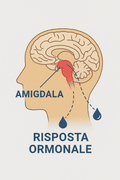Have you ever heard of post-traumatic stress disorder? It's a psychological condition of profound distress that can lead to serious consequences if not properly treated. But is it only a mental issue, or can it also cause specific physical symptoms? How does someone suffering from it behave? What are the signs we should interpret to recognize their struggle and help them?

PTSD is a mental health issue that can affect individuals or groups of people who have experienced the same traumatic event. It has no age boundaries and may affect not only direct victims but also family members, rescuers, or anyone closely involved in the aftermath of a traumatic occurrence.
What qualifies as a traumatic event?
A traumatic event isn't limited to war. It can be any extraordinary, shocking situation that leaves a deep mark on the psyche. Examples include:
- War and military conflict
- Terrorist attacks, bombings
- Major airplane crashes
- Genocides or mass extermination
- Severe natural disasters such as floods or earthquakes
These events have a powerful emotional impact. The syndrome may also develop in individuals exposed repeatedly to violent environments, including through media coverage in the case of children.
Historical context of PTSD
The term gained attention after the Vietnam War, where veterans returned with both physical and psychological trauma. Over time, PTSD was recognized as a legitimate diagnosis for trauma survivors in various contexts.
What is it exactly?
PTSD is a complex psychological condition triggered by an intense emotional experience. Personal and environmental factors contribute to how it manifests. Although diagnosis can be difficult, it is essentially a form of extreme stress.
Reactions vary, but studies show that children and adolescents exposed to constant traumatic content on TV, especially involving their country, are also vulnerable to developing PTSD.
PTSD and hormones

Research shows that people with PTSD produce abnormal hormone levels during stress or fear. The amygdala—a part of the brain—is responsible for regulating these responses. Normally, it helps to reduce fear, but in PTSD sufferers, the response is exaggerated and prolonged.
These individuals may also show altered blood flow in the brain and changes in brain tissue, contributing to emotional instability.
Is it easy to diagnose?
Diagnosis is not straightforward, but there are clear behavioral indicators:
- Difficulty controlling emotions
- Frequent irritability or emotional outbursts
- Feelings of guilt for surviving a traumatic event
- Tendency to avoid any reminder of the trauma
- Signs of depression and confusion
Physical symptoms
PTSD can also present with physical issues, such as:
- Chest pain or pressure
- Digestive issues
- Migraines or frequent headaches
Key diagnostic criteria
Symptoms usually begin within three months of the traumatic event. Key traits include:
- Sudden emotional flashbacks or vivid memories
- Complete avoidance of trauma-related people or situations
- Constant sense of danger, emotional instability, memory issues
Treatment approaches
Treatment typically includes a combination of medication and psychotherapy. Successful therapy often hinges on awareness of the condition and support from family and specialists.
What emotional impact does it have?
The emotional weight experienced by those suffering from PTSD is enormous. These individuals may feel cut off from the world around them, incapable of expressing what they feel or trusting others. Often, they don't even realize that they are suffering from a condition with a name. They might perceive themselves as "broken" or "weak," which reinforces the isolation and delays seeking help.
Those closest to the affected person—family, friends, colleagues—play a key role. It is often through their observation and support that the individual may become aware of the need for professional help. Even simple gestures, like listening without judgment, can be crucial in the healing process.
Trauma and identity
One of the most complex aspects of PTSD is how deeply it can affect personal identity. A person may begin to define themselves through the trauma they’ve experienced, losing contact with who they were before. This can affect not only self-esteem but also work performance, relationships, and physical health. A formerly calm and stable person may become reactive, withdrawn, or deeply anxious.
School and work life
In school settings, PTSD in children or teens can manifest as withdrawal, aggression, or apparent learning difficulties. In adults, it can interfere with concentration, memory, or the ability to interact with others. Absenteeism, decreased productivity, or abrupt changes in behavior may be red flags indicating emotional distress related to past trauma.
Importance of early support
Access to mental health professionals, especially in the early stages of symptoms, can greatly improve outcomes. The sooner the disorder is recognized and addressed, the more likely recovery will be lasting. In many cases, people delay seeking help due to stigma, fear, or simply lack of knowledge. This is why information and awareness are so important in both personal and social contexts.
A message of hope
Although PTSD is a serious and sometimes long-lasting disorder, recovery is absolutely possible. With the right tools and support, individuals can regain control of their emotional lives and even emerge stronger. Accepting the presence of the trauma, facing it with professional guidance, and rebuilding day by day is the path toward healing. You are not alone, and asking for help is a brave and vital act.